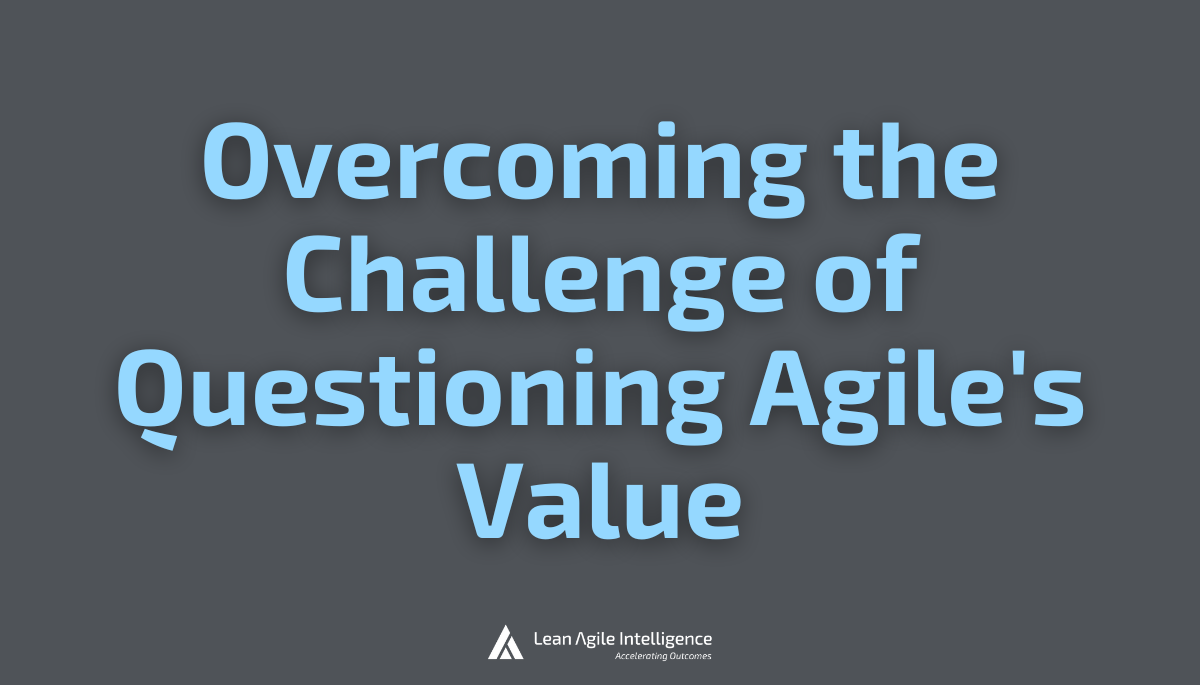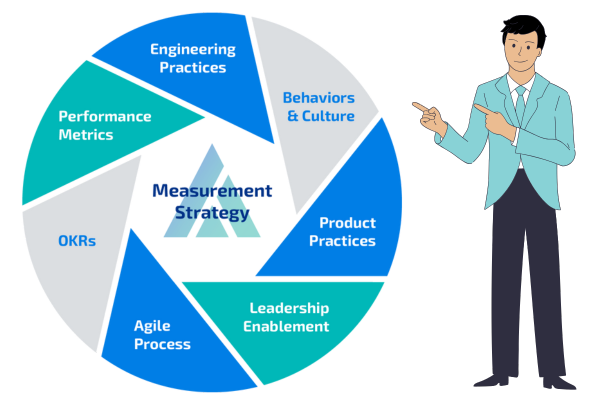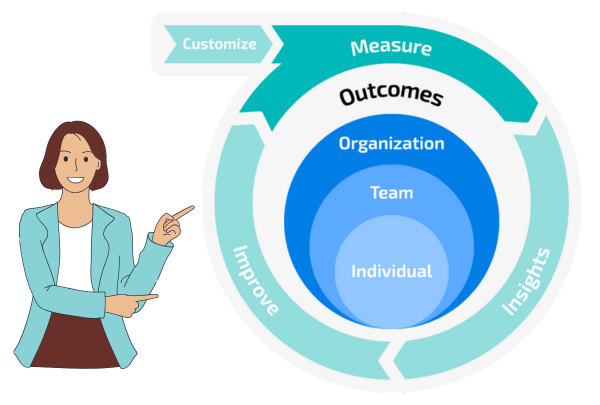Overcoming the Challenge of Questioning Agile Transformation's Value
By Michael McCalla

For many organizations, Agile transformation promises increased adaptability, faster innovation, and more engaged teams. However, as Agile practices become established, transformation leaders often face a challenging question from executives, stakeholders, and even team members: Is Agile delivering the promised value?
We often hear this from our customers. Many transformation leaders find themselves stuck between agile's high expectations and the realities of adoption, frequently needing to defend both the methodology and the resources devoted to it.
In this post, we explore why agile transformation's value is often questioned, the risks of leaving it unaddressed, and how a strategic approach to agile capability measurement & improvement can help organizations achieve the high expectations of agile.
Why Questioning Agile Transformation's Value is So Common
Many Agile initiatives start with high expectations. Leaders are promised faster delivery cycles, and better alignment with customer needs. However, organizations can feel disillusioned without early and consistent proof of these outcomes. This skepticism often emerges when agile teams are "going through the motions" without measurable improvement in productivity and quality.
Why Might Someone Question Agile Transformation's Value:
-
Lack of Initial Alignment and Vision for Agile Adoption: Without a clear and shared vision, it's hard to get buy-in from all stakeholders.
-
Lack of Measurable Outcomes: Without clear metrics and insights, justifying agile's impact on productivity and quality can be challenging. It's critical to distinguish between vanity metrics and actionable metrics to justify Agile's impact. Learn more about what actionable metrics are and how to use them.
-
Misalignment with Strategic Goals: Agile practices can appear disconnected from the organization's broader goals.
-
Burnout from Overuse of Ceremonies and Sprints: When agile is misapplied, teams may feel burdened rather than empowered.
The Implications of Questioning Agile Transformation's Value

When an organization questions Agile's effectiveness, several negative consequences can occur:
-
Reduced Engagement: Without confidence in agile, teams and leaders may disengage, treating agile practices as a formality rather than a valuable approach to work.
-
Missed Opportunities: Agile focuses on adapting to change and delivering value. If leaders don't apply it, they risk falling behind on customer needs and market shifts. However, if applied, they can significantly improve an organization's competitive edge. For an example, see the Doodle Case Study on achieving a competitive edge through continuous improvement.
-
Risk of Agile Stagnation: A skeptical view of Agile can lead to stagnation, turning practices rigid and ceremonial, undermining its core benefits.
The Solution: Agile Capability Measurement and Improvement

To restore confidence in agile, transformation leaders need a strategic approach that demonstrates tangible outcomes and maintains alignment with organizational goals. As we like to say at Lean Agile Intelligence, "they need to make it real."
Taking a strategic approach to agile transformation begins with revisiting the 'why' behind its adoption. Agile needs to be reframed as more than just a methodology but a critical enabler of outcomes essential to the organization's operating model, such as responsiveness and faster time to market. In today's digital landscape, these outcomes are key to staying competitive. This reframing builds a strong foundation for wider adoption, making it more likely that Agile will be embraced across the organization and set up for lasting success. This renewed focus fosters alignment and urgency. For a deeper dive into mastering Agile transformation, see this guide on orchestrating change.
An Agile Capability Measurement and Improvement Strategy provides a structured approach to keeping agile purposeful and effective over time. It becomes a mechanism for aligning Agile practices with strategic objectives, fostering a culture of ongoing improvement and collaboration. A Continuous Measurement and Improvement strategy provides:
-
Alignment with Organizational Goals: By tailoring Agile practices to the organization's specific needs, leaders can align the transformation with strategic objectives, keeping Agile integrated and relevant.
-
Clear Metrics for Success: This approach enables qualitative and quantitative insights, enabling leaders to track agile's tangible impact on productivity and team dynamics. Implementing clear metrics helps track tangible impacts on productivity and team dynamics. Explore how metrics can inform decision-making to guide your Agile transformation effectively.
-
Team Member Feedback Loops: Regular measurement and team feedback provide a complete view of Agile's effectiveness. This dual approach reveals performance trends and, more importantly, helps us understand the reasons behind them.
Benefits of Lean-Agile Capability Measurement and Improvement

By committing to Continuous Lean-Agile Measurement and Improvement, organizations gain several key benefits:
-
Renewed Confidence in Agile: The proof is in the numbers! Data-driven insights provide leaders with concrete evidence of agile's impact, restoring confidence among stakeholders and teams.
-
Increased Engagement: When leaders and teams see Agile's tangible value and alignment with their goals, they are more likely to engage in the adoption.
-
Sustained Agility: By continuously adapting agile practices based on real-time insights, organizations ensure that agile remains flexible, aligned, and valuable over the long term. Continuous measurement enables leaders to align Agile practices with strategic goals. Learn about the North Star Metric approach to focus your Agile transformation efforts.
Conclusion: Making Agile Transformation's Value Last
Questioning agile's value is a common challenge, but one that organizations must address to remain relevant in today's volatile business environment. It is a challenging task for transformation leaders and requires a strategic approach. An Agile Capability Measurement and Improvement strategy offers a structured way to keep Agile purposeful and effective over time. It serves as a mechanism to align Agile practices with strategic objectives and foster a culture of continuous improvement and collaboration. By embedding this approach, agile evolves from a methodology into a core part of the organization's culture, increasing the likelihood of delivering on agile's promise.
* * *
Start the Agile Capability Measurement and Improvement Journey:
With the Lean Agile Intelligence platform, agile transformation leaders can quickly get strategic through customization, comprehensive insights, and data aggregation.
-
Customization: By tailoring assessments to each organization's unique needs, leaders can address specific challenges and align agile practices with their broader goals.
-
Comprehensive Insights: The platform's qualitative and quantitative assessments provide a balanced view of Agile's effectiveness and improvement opportunities.
-
Data Aggregation: The platform's data aggregation capabilities offer a holistic view, ensuring alignment and enabling leaders to make cohesive, data-informed decisions.
Together, these advantages enable leaders to sustain and adapt agile practices continuously, maximizing Agile's impact organization-wide.
To learn more or to evaluate Lean Agile Intelligence in your context, contact us today!